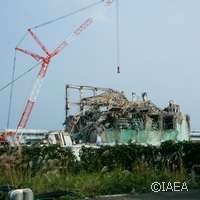Credit: IAEA
On March 11 2011, the world watched in awe at the sheer destructive power of the tsunami that struck Japan. The tsunami followed an earthquake off the east coast of Japan, which reached 9.0 on the Richter scale - the largest quake ever to hit Japan. The ensuing tsunami swept across cities and farmland in the northern part of the country, killing as many as 20,000 people. In the wake of the tsunami, however, another disaster emerged, the Fukushima Daiichi nuclear disaster, which has been referred to by some as the largest nuclear disaster since the Chernobyl disaster of 1986.
Scientists have highlighted this disaster as a wake-up call, and one team of scientists has assessed 'potentially dangerous' areas that are home to completed nuclear plants or those under construction. By highlighting high-risk zones, they hope that further plans can be implemented to head off similar disasters.
The study is the first to look into the location of nuclear power plants and correlate them to areas at risk of tsunamis. 'We are dealing with the first vision of the global distribution of civil nuclear power plants situated on the coast and exposed to tsunamis,' explained José Manuel Rodríguez-Llanes, co-author of the study and researcher at the Centre for Research on the Epidemiology of Disasters (CRED) of the Catholic University of Leuven in Belgium. To inform their analysis, the authors used historical, archaeological, geological and instrumental records as a base for determining tsunami risk.
Their study, published in the journal Natural Hazards, presented a map of the world's geographic zones that are more at risk of large tsunamis. Based on these data, 23 nuclear power plants with 74 reactors have been identified in high-risk areas. One of them includes Fukushima I. Of these, 13 plants with 29 reactors are active; another 4, that now have 20 reactors, are being expanded to house 9 more; and there are 7 new plants under construction with 16 reactors.
Despite the fact that the risk of these natural disasters threatens practically the entire western coast of the American continent, the Spanish/Portuguese Atlantic Coast and the coast of north Africa, it is the eastern Mediterranean and areas of Oceania, especially in south and south-east Asia, that are at greater risk due to the presence of atomic power stations.
According to Debarati Guha-Sapir, another co-author of the study and CRED researcher, 'the impact of natural disaster is getting worse due to the growing interaction with technological installations'.
China, one of the world's fastest growing economies in the world is also where the largest number of nuclear reactors are being constructed: some 27 of 64 that are currently under construction around the world. 'The most important fact is that 19 (2 of which are in Taiwan) out of the 27 reactors are being built in areas identified as dangerous,' state the authors of the study.
Meanwhile in Japan, which served as the inspiration for the study, there are 7 plants with 19 reactors at risk, one of which is currently under construction. South Korea is expanding two plants at risk with five reactors. India (two reactors) and Pakistan (one reactor) could also feel the consequences of a tsunami in the plants.
'The location of nuclear installations does not only have implications for their host countries but also for the areas which could be affected by radioactive leaks,' outlined Joaquín Rodríguez-Vidal, lead author of the study and researcher at the Geodynamics and Paleontology Department of the University of Huelva, Spain.
According to the study, we should learn our lessons from the Fukushima accident. For the authors, prevention and previous scientific studies are the best tools for avoiding such disasters. 'But since the tsunami in 2004, the Indian Ocean region is still to take effective political measures,' warn the researchers.
The Fukushima crisis took place in a highly developed country with one of the highest standards in scientific knowledge and technological infrastructure. 'If it had occurred in a country less equipped for dealing with the consequences of catastrophe, the impact would have been a lot more serious for the world at large,' claim the experts. Therefore, Professor Rodríguez-Vidal recommends the drafting of more local analyses that consider the seismic amplification of each nuclear power plant and determine the adaptation of installation identified in the study.
More information:
Rodríguez-Vidal, J. et al. 'Civil nuclear power at risk of tsunamis', Natural Hazards, 2012 63 (2) : 1273-1278. doi: 10.1007/s11069-012-0162-0
earthobservatory.nasa.gov/NaturalHazards/
Provided by CORDIS
























